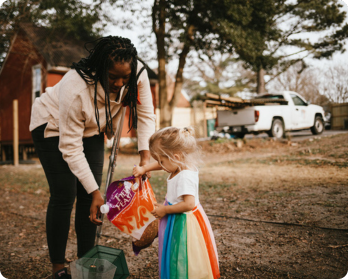You’re about to sign a mortgage loan. It’s a huge financial commitment. What exactly are you getting into? The Closing Disclosure is all about making sure you have a really clear answer to that question, so you can close on your new home with no worries.
Required by federal law for all home purchases, this core mortgage document itemizes the final terms of your loan in a straightforward, organized way. Every number is right there. It’s based on, and refers to, another federally required form, the Loan Estimate that you got when you first applied for your loan.
But how do you read the Closing Disclosure? Five pages! What does it all mean? To help you get oriented, we’re going to walk you through the six big-money numbers. But first, here are some things you should know about it:
- Your lender has to get the Closing Disclosure to you at least three business days before you close on your home
- It’s your responsibility to review the Closing Disclosure and ask questions about anything you don’t understand
- It’s your lender’s responsibility to get the numbers right
- By law, the terms and most of the numbers should be the same or close to those on your original Loan Estimate
- If something changed that shouldn’t have, and you don’t realize it before closing, you have up to three years to cancel your loan
- It’s a notice, not a contract, but you might be asked to sign it, or a form acknowledging that you got it
Review the entire Closing Disclosure very carefully before you sign your loan documents. (Here’s a guide to your other closing documents.) We can’t emphasize this enough. Be sure to compare it to your original Loan Estimate — surprises are a red flag. Mistakes do happen, but if anything’s out of line, your lender might be breaking the law.
Once you’ve got your Closing Disclosure, make a date with the Consumer Finance Protection Bureau’s interactive explainer. It’s a great tool that goes over the entire form point by point and helps you make sure you don’t overlook anything.
Now here are the six big-money numbers and where to find them. Note that the info in the Closing Disclosure is organized under black “tabs,” which we refer to in each section below. Again, don’t hesitate to go to your lender or closing agent with questions!
Big number 1: How much cash you need to close
This figure is top of mind for most homebuyers, so you might want to jump right to it and end the suspense — although you shouldn’t be too surprised. It includes your down payment and all closing costs. Since you need to either get a certified check or do a wire transfer, you need to know the exact amount ahead of the closing so you can get to your bank.
Where to find it:
- Page 1, Costs at Closing tab
- Page 3, Calculating Cash to Close tab
Big number 2: The exact amount of your loan
The total loan amount is the purchase price minus your down payment, plus any closing costs you might be folding into the loan. If your down payment is small and you’re financing your closing costs, the amount you’re borrowing could be bigger than the price of your home.
Where to find it:
- Page 1, Loan Terms tab, Loan Amount
Big number 3: Your final interest rate
This one is big in the sense of important. Hopefully, you locked in your interest rate when you applied for your loan (there’s a fee). If so, it should be the same as it was on the Loan Estimate — unless the lock has expired, which can happen if it takes a long time to close.
Now, is your rate fixed or adjustable? Please say fixed — we don’t recommend adjustable interest rates for first-time homebuyers. A fixed-rate can’t ever go up, and the Closing Disclosure should stipulate that.
Where to find it:
- Page 1, Loan Terms tab, Interest Rate
- Page 1, Loan Terms tab, “Can this amount increase after closing?”
Big number 4: How much you’re really paying for your home
It’s important to understand this. Thanks to many years of interest, you’ll ultimately pay way more for your home than the purchase price. The Closing Disclosure shows you exactly how much, assuming that you make all your payments on time, in the scheduled amounts. It’s a sobering number.
The good news is that you can potentially save a huge amount on interest if you make extra payments on principal, especially in your early years of homeownership.
Where to find it:
- Page 5, Loan Calculations tab, Total of Payments
Big number 5: Your total closing costs
Page two of the Closing Disclosure is devoted to the variety of fees and deposits you need to pay to wrap up your loan. Are you paying discount or origination points? If so, the fee is considered to be a closing cost, so you’ll find it here. It should match the Loan Estimate.
Where to find it:
- Page 2
Heads-up: “Total loan costs” is not the same as “total closing costs,” which you’ll find on line J at the bottom of the page.
Big number 6: Your monthly mortgage payment
By now, you must be familiar with the components of your monthly mortgage payment: principal, interest, taxes, and insurance (PITI). The Closing Disclosure breaks your payment into just three parts:
- Principal and interest
- Mortgage insurance if you need it
- Estimated escrow
Your escrow account is a long-term account established by your lender at closing. It holds the portion of your monthly payment that goes toward annual property taxes, mortgage insurance, and sometimes homeowners insurance. Because taxes and insurance premiums change, the Closing Disclosure can only estimate this figure.
Where to find it:
- Page 1, Projected Payments tab
What if something’s fishy?
Is your Closing Disclosure wrong? Bring it to the attention of your lender or closing agent right away. Like we said, mistakes do happen. But if you get the runaround or it feels weird, trust your instincts and press pause. If your closing agent is your own real estate attorney, they’re probably already on it, but call them ASAP. Otherwise, a good first stop is a homeownership advisor.
Ready to take the next step in your homebuying journey with all the confidence of a smart and savvy homebuyer? Our comprehensive online homebuyer education course is simple and easy to access on your computer, tablet, and mobile device. It’s all the information you need, all in one place. Go ahead and get started today.




